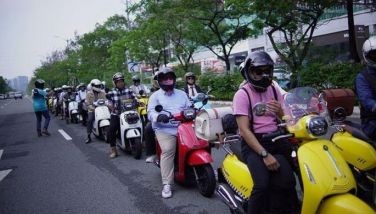Arrive Alive
MANILA, Philippines - Ours is not a dangerous profession. Or is it? Compared to, say, soldiers or laborers, we do not deal with Death on a daily basis. Nobody shoots at us, there’s little danger of getting trapped in a mine or falling off a high-rise construction, but now that I think about it it’s still quite possible to get in a few scrapes with all the driving that we do.
A motoring journalist drives and writes about cars all year long. When you consider that a car can be quite a deadly object when put to (mis)use, the thought can be chilling. Hundreds of people die every year from driving-related accidents. Buses fall off cliffs. “Car meets Truck” and carnage ensues. A tire blows at high speed and an untrained driver panics, causing the vehicle to flip and crush its passengers.
Yet for all the hundreds of miles that the average motoring journalist logs in a year, almost all of us are in pretty good shape. It has gotten to a point where few of us quail at the prospect of undergoing a 1,000 kilometer round trip in just a few days for the purpose of a story. I recently finished one myself, along with my wife: 900+ kilometers to and from Camarines Sur, driving through the often-fatal Quezon province where it seems a provincial bus falls into a ravine every week.
Indeed, a day after we arrived in CamSur, BB. Pilipinas titlist Melody Gersbach and her friends were killed when they collided head-on with a bus. My wife and I made the trip unscathed, but we were careful the whole time. We had but two hair moments. First, following a van that was overtaking a truck, the van pulled back into the lane just as an oncoming car came into view. Luckily, a flash of high beams and a hasty wave encouraged the oncoming driver to slow down so we could merge back. Second, on the wet zigzag roads of Quezon, the Expedition we were driving hit a patch of rippled asphalt, causing us to actually slide sideways by a meter or so. Again, luck was on our side; traffic was light and we weren’t going so fast as to lose control.
But luck really is what you make of it. Those two incidents could have gone very badly if we weren’t careful. When I think about it, being careful has allowed us to drive thousands of kilometers across the country (sometimes even in other countries) without a hitch.
Here are a few tips I’ve compiled that have kept us safe (and sane!) on every journey:
Bring company – Anytime you’re driving several hours, a companion or two will help stave off boredom and fatigue and spell you at the wheel. Choose wisely: you want someone you can get along with, someone who won’t go insane after too many hours driving, and of course, someone who can drive.
Fuel early – Especially if your vehicle requires high-octane gasoline, where the type may be hard to find the farther you go from the city. If you’re loathe to carry a lot of cash, it’s not unknown to have to fill up at a station in the middle of nowhere that doesn’t take plastic.
Bring a map – And learn how to read it. GPS is fine, but even computers get confused plotting out routes. I always bring an EZ-Map road book with me. Learn how to orient yourself and how to read all those squiggly lines and little numbers so the journey becomes less daunting.
Bring food and drink – A cooler with your preferred drinks and a bag of your favorite munchies or sandwiches lessens the time you need to stop for breaks.
Pace yourself appropriately – I outgrew crazy-fast driving a few years ago, which is not to say that I drive slow. Any road has an appropriate pace that allows you to cover ground quickly without pushing the limits of yourself or the vehicle’s. A road trip is more marathon than sprint. If you go too slowly, you become a hazard and everyone will want to cut you off. If you go too fast, you can actually overshoot a crucial turn or miss a critical road sign.
Monitor your senses – The most dangerous time to drive is when you’re sleepy: reaction times slow down, judgment becomes impaired. If you notice that you’re beginning to feel drowsy or have taken to snapping at your companion(s), it’s time to let someone else drive. I once went 22 hours without so much as a nap, and 9 of those were spent driving. I knew my mental state was screaming for rest when I was gunning the engine at red lights and overtaking everything in sight!
Take down notes – You’ll probably do the same road trip again a few months or years from now. Note down critical landmarks and interesting places to stop and eat so you’ll make better progress next time. It helps to ease the anxiety.
Be especially wary of motorcycle riders – While you enjoy the protection of a car that’s wrapped around you, these guys have just a jacket and a helmet... and sometimes not even that! And they can be oblivious to their surroundings at high speed, so give them a wide berth since they’re just a few heartbeats away from a bad accident. Going home from Tarlac last year, I passed a grisly scene where two trucks had collided. Behind one was a crushed motorcycle. Fifty feet away was the mangled body of the rider. It appeared like he had been tailgating one truck right until it had smashed into the other.
Load up properly – Don’t just throw your stuff in the back. Put the heaviest, bulkiest items closest to the floor and secure everything properly. I always bring a set of bungee cords on my trips. This way you preserve your vehicle’s center of gravity, aiding its handling.
Say a prayer – When it’s time to go, it’s time to go. But until then, it won’t hurt to ask for a little help from above so you don’t arrive at the pearly gates earlier than planned.
James Deakin’s “Coding Conundrum” ignited a discussion amongst Backseat Drivers last week. Here are some of the comments…
You can thank all the Mayors of Metro Manila for the chaos. All of them were envious of the MMDA Chairman and they stymied all of his efforts to unify traffic in Metro Manila and proceeded to implement their own traffic schemes in complete disregard of the greater good. Thank you Binay, thank you Ejercito, et al. – mulatnajuan
A classic example of this is at the entrance to EDSA when coming in from Kalayaan Avenue in the Fort. Just before the foot of the flyover that leads to the Southbound lanes of EDSA and the right hand turn into the Northbound lanes, you may notice two Makati traffic cops (MAPSA) in their yellow and brown uniforms – SORRY TO SAY BUT THESE ARE KOTONG COPS. Their sole purpose is manghuli/mangotong... I’ve seen them there so many times, causing heavy traffic... – joseinaki
Maybe now that Binay is the VP he could finally impose what is right and not throw his weight around like before. Let’s have a unified traffic scheme please and also standardized penalties. – brondial
- Latest




























